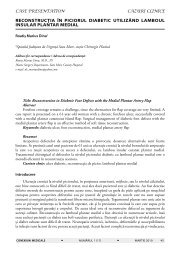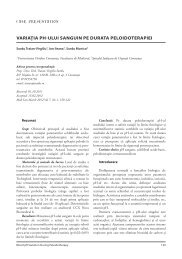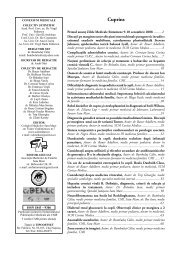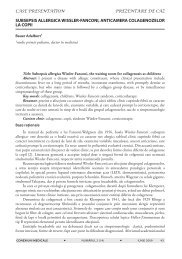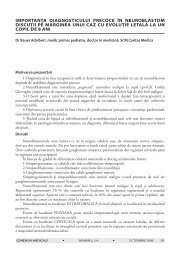SURGICAL TREATMENT OF HyPOSPADIAS - Conexiuni Medicale
SURGICAL TREATMENT OF HyPOSPADIAS - Conexiuni Medicale
SURGICAL TREATMENT OF HyPOSPADIAS - Conexiuni Medicale
Create successful ePaper yourself
Turn your PDF publications into a flip-book with our unique Google optimized e-Paper software.
ORIgInAL ARTIcLEs<br />
sUrGical treatment of hypospadias: technical<br />
procedUres and resUlts<br />
Stanca Dan Vasile, Prundus Paul, Boc Andrei, Manescu Razvan Mihai, Coman Ioan<br />
Clinical Municipal Hospital Cluj Napoca, Pediatric Urology Department<br />
Address for correspondence:<br />
Dan Vasile Stanca<br />
Clinical Municipal Hospital, Urology Department<br />
11 Tabacarilor Street, 400331 Cluj-Napoca, Romania<br />
phone: +40744.622.933; +4035.406.182, fax: +40264.485.295<br />
Email: vasilestanca@yahoo.com<br />
Received: 31.01.2012<br />
Accepted: 20.05.2012<br />
Med Con June 2012, Vol 7, No 2, 31-34<br />
Abstract<br />
Hypospadias has an important influence on the<br />
sexual life and fertility of teenagers and young men. We<br />
present the results obtained in our department by using<br />
various urethroplasty techniques for congenital urethral<br />
defects.<br />
Material and methods: We evaluated the data of<br />
patients treated in our department for hypospadias<br />
between 2004 and 2011. For urethroplasty we used<br />
Tiersch-Duplay, Duckett and Snodgrass techniques. A<br />
urethral catheter and a suprapubic bladder catheter were<br />
used for bladder drainage in the postoperative period.<br />
We recorded the type of urethroplasty, the results and<br />
complication rate.<br />
Results: Twenty-five boys with different grades of<br />
severity of hypospadias were treated in our department.<br />
Fourteen children were treated only in our department;<br />
the other 11 children had antecedents of multiple<br />
urethroplasties done in other medical services. We opted<br />
for the Tiersch-Duplay or Duckett technique for<br />
proximal hypospadias and we preferred the Snodgrass<br />
technique for the distal variety. We recorded a failure<br />
rate after the first surgical intervention (urethrocutaneous<br />
fistula) of 55% on patients with proximal<br />
hypospadias; the results were improved only after the<br />
routine use of a dartos flap for covering the neo-urethra.<br />
For patients with distal hypospadias, the percentage of<br />
post-operative complications (urethral stenosis) was<br />
10%. We did not record any incidents during the<br />
suprapubic bladder drainage.<br />
Conclusions: Hypospadias (especially proximal<br />
hypospadias) is still a challenging disease. Routine use of<br />
the suprapubic bladder drainage and of dartos flaps<br />
offers better results.<br />
Keywords: hypospadias, urethroplasty, suprapubic<br />
bladder drainage<br />
Introduction<br />
Hypospadias is a disease that occurs as a result of an<br />
abnormal embryogenesis of the urethra. This pathology<br />
entails esthetical and functional issues. It is not<br />
uncommon that patients develop inferiority complexes,<br />
aggravated by the difficulty of normally directing the<br />
urinary stream while standing, that in turn imposes a<br />
Surgical Treatment Of Hypospadias: Technical Procedures And Results 31
ORIgInAL ARTIcLEs<br />
sitting-down position while urinating. Severe<br />
hypospadias may interfere with the semen deposit in the<br />
vagina during intercourse.<br />
Hypospadias is associated with the following<br />
pathological situations:<br />
– The glans does not have a conical aspect; it is<br />
flat, with spread wings;<br />
– The foreskin has a hood-like appearance,<br />
dorsally oriented. As an exception we mention<br />
the cases with megameatus and intact foreskin.<br />
The anomaly is discovered accidentally during a<br />
circumcision;<br />
– At least 15% of cases present a ventral penile<br />
curvature. This is generated by insufficient<br />
development of the ventral penile structures<br />
and tissues;<br />
– External urethral meatal stenosis.<br />
Hypospadias caught the attention and therapeutic<br />
efforts of many surgeons and urologists. Over 200<br />
surgical techniques described and 4800 medical articles<br />
published and indexed in Pubmed database signal the<br />
fact that there are still unmet needs regarding the<br />
etiology and treatment of this disease. The failure rate<br />
after surgery is still too high and this is all the more<br />
frustrating if we consider the accessibility of the organ<br />
for clinical examination and surgery and the availability<br />
of well vascularized tissues for urethroplasty.<br />
Over the years the surgical techniques used for the<br />
urethroplasty have evolved. Initially the structure used for<br />
surgery was the urethral plate; later various skin grafts<br />
were used, and then vascularized cutaneous flaps, buccal<br />
mucosa grafts, bladder mucosa grafts, only to go back to<br />
the urethral plate and penile skin once again. The surgical<br />
techniques differ in the basic principles and the type of<br />
hypospadias for which they are designed (proximal, dorsal,<br />
with/without penile curvature, firstly operated or multiple<br />
relapse). The large number of surgical techniques may not<br />
offer a surgeon the opportunity to accumulate enough<br />
experience with each one of it, placing him always on the<br />
beginning of the learning curve. This situation leads to<br />
disappointing results; it would be therefore useful to limit<br />
oneself to a limited number of surgical procedures which<br />
can be used successfully in most cases of hypospadias.<br />
Our aim is to evaluate the surgical techniques used<br />
and results obtained in our department with different<br />
types of urethroplasties designed for urethral congenital<br />
defects.<br />
32<br />
Material and Methods<br />
We evaluated the data of pediatric patients treated<br />
in our department for hypospadias between 2004 and<br />
MEDICAL CONNECTIONS • NUMBER 2 (26) • JUNE 2012<br />
2011. For proximal hypospadias the urethroplasty was<br />
made using the Tiersch-Duplay or Duckett techniques.<br />
For the distal type of hypospadias we preferred the<br />
Snodgrass repair. For the first cases the urine drainage<br />
was made by a urethral catheter; then through a<br />
suprapubic bladder catheter. We recorded the results<br />
obtained and the postoperative complication rate.<br />
Twenty-five boys aged 18 months to 15 years were<br />
treated in our department. They had hypospadias with<br />
different degrees of severity. Fourteen children were<br />
firstly operated in our service. Eleven children had<br />
previous interventions done in other medical services.<br />
Ten boys had distal hypospadias, twelve patients had the<br />
urethral meatus on the mid shaft and three had it at the<br />
level of the perineum.<br />
Results<br />
Proximal hypospadias (Figure 1) was operated using<br />
the Tiersch-Duplay technique (on children with goodquality<br />
urethral plate) or the Duckett technique (in case<br />
of compromised plate due to scarring or chordee). The<br />
main surgical steps in the urethroplasty with preputial<br />
pediculated flap are presented in Figures 2-6.<br />
For the distal hypospadias (Figure 7) we preferred<br />
the Snodgrass repair.<br />
We recorded good cosmetic and functional results<br />
following the first intervention on 90% of patients with<br />
distal hypospadias (Figure 8) and 45% of patients with<br />
penile or perineal meatus (Figure 9).<br />
In patients with proximal hypospadias we recorded<br />
a failure rate of 55%: 2 cases with total dehiscence and 6<br />
cases with urethro-cutaneous fistula (Figure 10). We<br />
obtained the best results in patients without previous<br />
surgery of the penis, to whom the bladder was drained<br />
through a suprapubic catheter and whose urethra was<br />
covered using a pediculated dartos flap.<br />
For children with distal hypospadias, the percentage<br />
of postoperative complications was 10% (one case of<br />
urethral stenosis). We did not record any incidents<br />
regarding the insertion of the suprapubic catheter.<br />
Discussions<br />
The correcting surgical intervention needs to reach<br />
more goals: ortoplasty (correction of the penile<br />
curvature, when present), urethroplasty (creating a<br />
neourethra from the hypospad meatus to the extremity<br />
of the gland) and glanuloplasty (creating a normal<br />
aspect glans) [1]. The multitude of surgical procedures<br />
described suggest that the perfect operation has yet to be<br />
invented.<br />
Stanca et al
MEDICAL CONNECTIONS • NUMBER 2 (26) • JUNE 2012<br />
Figure 1. Proximal hypospadias<br />
Figure 3. Preputial flap<br />
tubularization on a 10 Fr tube<br />
Figure 5. Anastomosis of the<br />
neourethra to the hypospad<br />
urethral meatus<br />
Figure 7. Coronal hypospadias<br />
Figure 9. The aspect of the penis<br />
at 3 weeks after Tiersch-Duplay<br />
and Snodgrass urethroplasty at<br />
an 11 year old boy with<br />
proximal hypospadias and 3<br />
failed previous urethroplasties<br />
Figure 2. The preputial flap is<br />
disected. We use stay sutures for<br />
tissue manipulation to<br />
minimize local trauma<br />
Figure 4. Vascularized<br />
preputial tube<br />
Figure 6. Urinary drainage is<br />
assured by a urethral catheter<br />
and a suprapubic bladder<br />
catheter<br />
Figure 8. The aspect of the<br />
penis at 3 months after the<br />
Snodgrass uretheroplasty for<br />
coronal hypospadias<br />
Figure 10. Urethro-cutaneous<br />
fistula after hypospadias surgery<br />
ORIgInAL ARTIcLEs<br />
Nowadays there is a trend of opinion that states the<br />
need to identify operative principles that can be applied<br />
to the majority of cases. They simplify the decisionmaking<br />
process and allow the pediatric urologist to<br />
accumulate experience:<br />
– all the therapeutic objectives should be attained<br />
within a single surgical intervention. In our<br />
experience we managed to finalize all<br />
interventions in this manner. Severe cases with<br />
multiple prior interventions or associated<br />
anomalies (cryptorchidia) may require serial<br />
interventions.<br />
– the urethral plate should be used whenever<br />
possible for urethroplasty. The vascularized skin<br />
flaps or bladder mucosa should form the<br />
neourethra together with the urethral plate and<br />
not by themselves through tubularization. A<br />
well anchored neourethra with low risk of<br />
fistula or stenosis is obtained in this manner. In<br />
case of severe chordee ortoplasty by Nesbit<br />
procedure leads to an important reduction in<br />
penile length. In this case the urethral plate<br />
should be incised and the above-mentioned<br />
structures (prepuce, penile skin, buccal mucosa)<br />
should be used instead [2].<br />
We used the Tiersch-Duplay and Duckett<br />
techniques for all cases of proximal hypospadias. We<br />
tubularized the pediculated preputial flap only in cases<br />
in which the fibrous scar tissue on the ventral face of the<br />
penis had to be excised.<br />
– In case of insufficient width for tubularization,<br />
the urethral plate should be incised in the Snodgrass<br />
manner for a tension-free suture [3]. The main long<br />
term risk of this approach is the stenosis of the<br />
neourethra or the external urinary meatus [4]. We<br />
operated five cases of distal hypospadias using this<br />
technique; the only complication we encountered was<br />
meatal stenosis in one case. This was resolved in one<br />
session with urethral calibration. The good results<br />
encouraged us to use it as an addition to the Tiersch-<br />
Duplay urethroplasty on the distal segment of the<br />
urethra, where the dissection of the glans wings for<br />
glanuloplasty might lead to a narrower urethral plate.<br />
– Interposition of a dartos flap between the skin<br />
and the neourethra diminishes the risk of postoperative<br />
urethro-cutaneous fistula. We can use the preputial<br />
dartos (for distal hypospadias) or the scrotal dartos (for<br />
proximal dartos). The vascularized flap must be long<br />
enough not to cause postoperative chordee. Extensive<br />
preparation of this flap may have a negative effect on the<br />
vascularization; microsurgery dissection techniques<br />
allow for better results [5-7].<br />
Surgical Treatment Of Hypospadias: Technical Procedures And Results 33
ORIgInAL ARTIcLEs<br />
– Urethral catheter should not be used for bladder<br />
drainage. The urine is to be evacuated through a<br />
suprapubic catheter. In this manner the postoperative<br />
pain and erections due to manipulation of the urethral<br />
catheter are avoided. This type of approach allowed us<br />
to avoid these unpleasant incidents that otherwise<br />
would have required administration of ketoconazole or<br />
Amil Nitrate [8,9].<br />
– The operative wound should be handled as little<br />
as possible in the first 7 days postoperatively. Antibiotic<br />
ointments or special penile foam dressings that protect<br />
the penis and urethra for 5-7 days have proved to be<br />
especially helpful.<br />
– The preputium is not to be excised at the moment<br />
of the urethroplasty. A “cosmetic” intervention is to be<br />
done preferably several years after the initial intervention,<br />
when the penis attains its definitive dimensions<br />
following puberty. Circumcision done at the same time<br />
as the urethroplasty creates the risk of not having<br />
enough tissue available for a possible postoperative<br />
complication such as urethro-cutaneous fistula or<br />
dehiscence of sutures.<br />
The quality of penile tissues has a major influence<br />
on the result of the urethroplasty. A scarred penis forces<br />
us to adapt the surgical technique (tubularizing the<br />
preputial flap or buccal mucosa graft) if the nearby<br />
tissues are poorly vascularized or the foreskin is lacking.<br />
34<br />
Conclusions<br />
The surgical approach of hypospadias is still an<br />
intervention with significant complication risks.<br />
Identifying several surgical techniques suitable for the<br />
majority of cases allows for better results and up scaling<br />
of the learning curve.<br />
MEDICAL CONNECTIONS • NUMBER 2 (26) • JUNE 2012<br />
The Tiersch-Duplay, Duckett and Snodgrass<br />
techniques allowed us to treat all cases of proximal and<br />
distal hypospadias.<br />
References<br />
1. Coman I, Stanca DV: Urologie pediatrică. Cazuri<br />
clinice comentate. Iuliu Hațieganu Medical<br />
Universitary Publishing, Cluj-Napoca, 2008.<br />
2. Snodgrass WT, Bush N, Cost N. Algorithm for<br />
comprehensive approach to hypospadias reoperation<br />
using 3 techniques. J Urol 2009;182(6):2885-91.<br />
3. Snodgrass WT. Tubularized incised plate urethroplasty<br />
for distal hypospadias. J Urol 1994;151:464-465.<br />
4. Sarhan O, Saad M, Helmy T, Hafez A. Effect of suturing<br />
technique and urethral plate characteristics on complication<br />
rate following hypospadias repair: a prospective randomized<br />
study. J Urol 2009;182(2):682-6.<br />
5. Coman I, Ciuce C, Lucan M, Georgescu D, Mugea<br />
T, Moraru E, Mircioiu D. Uretroplastia<br />
microchirurgicală în hipospadias. Timișoara Medicală<br />
1995;3-4,XL:72-77.<br />
6. Ciuce C, Coman I. Reconstrucția penisului, în Lucan<br />
M, Tratat internațional de tehnici chirurgicale în<br />
urologie, ed. Clusium, Cluj-Napoca, 1996, pp652-<br />
660.<br />
7. Ciuce C. Microchirurgia peniană. În Coman I, Ciuce<br />
C. Microchirurgia în urologie – aplicații clinice. Ed.<br />
Grinta, Cluj-Napoca, 2002;54-93.<br />
8. Stock JA, Kaplan GW. Ketoconazole for prevention of<br />
postoperative penile erection. Urology 1995;45(2):308-<br />
9.<br />
9. Horton CE Jr, Horton CE. Complications of<br />
hypospadias surgery. Clin Plast Surg 1988;15(3):371-9.<br />
Stanca et al



